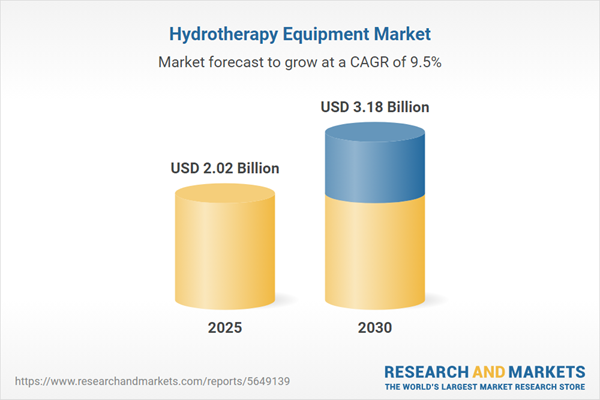The Hydrotherapy Equipment Market, valued at US$2.02 billion in 2025, is projected to grow at a CAGR of 9.47%, reaching a market size of US$3.18 billion by 2030.
The growing prevalence of back pain or arthritis, either due to old age or the adoption of unhealthy living conditions, is projected to drive market expansion during the forecast period. The increasing number of injuries occurring due to sports activities is further augmenting the market growth. The growing geriatric population worldwide also provides an impetus to surging demand.
The growing prevalence of back pain or arthritis, either due to old age or the adoption of unhealthy living conditions, is projected to drive market expansion during the forecast period. The increasing number of injuries occurring due to sports activities is further augmenting the market growth. The growing geriatric population worldwide also provides an impetus to surging demand.
Market Trends:
- Rising Prevalence of Musculoskeletal Disorders: The increasing incidence of musculoskeletal disorders, driven by lifestyle changes, is creating significant market opportunities. These conditions, which cause chronic pain, injuries, and stress, are fueling demand for physical rehabilitation solutions, thereby boosting the hydrotherapy equipment market. According to the WHO, around 1.71 billion people suffer from musculoskeletal conditions, making it a leading cause of global disability. Low back pain, in particular, is the primary cause of disability in 160 countries, further driving the demand for hydrotherapy and related equipment.
- Adoption of Smart Hydrotherapy Equipment: The integration of IoT in hydrotherapy equipment is gaining traction, enabling real-time patient monitoring. Automated control systems, such as pressure and temperature sensors, allow for adjustments in therapy settings based on individual patient needs, enhancing the effectiveness of treatments.
- AI and Mobile Integration: Artificial intelligence is increasingly being used to analyze sensor data, enabling data-driven decisions. Mobile applications and interactive touchscreens are also being incorporated to allow for real-time adjustments and personalized therapy experiences.
- Asia-Pacific’s Growth Potential: The Asia-Pacific region is expected to witness substantial growth during the forecast period, driven by a rapidly aging population, particularly in Japan, which has the world’s largest senior population. Increased government investments in healthcare infrastructure are further supporting market expansion in the region.
- North America’s Market Dominance: North America is anticipated to hold a significant market share due to the high healthcare expenditure in the U.S., the highest among developed regions. The prevalence of musculoskeletal disorders in the U.S. is a key driver of market demand. According to the United States Bone and Joint Initiative, chronic musculoskeletal conditions account for approximately $332 billion in healthcare spending, underscoring the substantial market potential for hydrotherapy equipment.
Key Benefits of this Report:
- Insightful Analysis: Gain detailed market insights covering major as well as emerging geographical regions, focusing on customer segments, government policies and socio-economic factors, consumer preferences, industry verticals, and other sub-segments.
- Competitive Landscape: Understand the strategic maneuvers employed by key players globally to understand possible market penetration with the correct strategy.
- Market Drivers & Future Trends: Explore the dynamic factors and pivotal market trends and how they will shape future market developments.
- Actionable Recommendations: Utilize the insights to exercise strategic decisions to uncover new business streams and revenues in a dynamic environment.
- Caters to a Wide Audience: Beneficial and cost-effective for startups, research institutions, consultants, SMEs, and large enterprises.
What can businesses use this report for?
Industry and Market Insights, Opportunity Assessment, Product Demand Forecasting, Market Entry Strategy, Geographical Expansion, Capital Investment Decisions, Regulatory Framework & Implications, New Product Development, Competitive Intelligence.Report Coverage:
- Historical data from 2022 to 2024 & forecast data from 2025 to 2030
- Growth Opportunities, Challenges, Supply Chain Outlook, Regulatory Framework, and Trend Analysis
- Competitive Positioning, Strategies, and Market Share Analysis
- Revenue Growth and Forecast Assessment of segments and regions including countries
- Company Profiling (Strategies, Products, Financial Information, and Key Developments among others)
Hydrotherapy Equipment Market is analyzed into the following segments:
By Product Type
- Hot Tubs
- Pools
- Whirlpool Spas
- Thermal Capsules
- Others
By Hydrotherapy Type
- Water Circuit Therapy
- Aquatic Exercise
- Aquatic Massage
- Steam Baths
- Saunas
By End-User
- Health Centers
- Spas
- Home
By Region
- North America
- Europe
- Asia Pacific
- South America
- Middle East & Africa
Table of Contents
1. INTRODUCTION
2. RESEARCH METHODOLOGY
3. EXECUTIVE SUMMARY
4. MARKET DYNAMICS
5. HYDROTHERAPY EQUIPMENT MARKET BY PRODUCT TYPE
6. HYDROTHERAPY EQUIPMENT MARKET BY HYDROTHERAPY TYPE
7. HYDROTHERAPY EQUIPMENT MARKET BY END-USER
8. HYDROTHERAPY EQUIPMENT MARKET BY GEOGRAPHY
9. COMPETITIVE ENVIRONMENT AND ANALYSIS
10. COMPANY PROFILES
11. APPENDIX
Companies Mentioned
- EWAC Medical
- India Medico Instruments
- BTL
- Technomex
- Westcoast Hydrotherapy Ltd.
- RMS Co.
- Reval Group
Methodology

LOADING...
Table Information
| Report Attribute | Details |
|---|---|
| No. of Pages | 142 |
| Published | March 2025 |
| Forecast Period | 2025 - 2030 |
| Estimated Market Value ( USD | $ 2.02 Billion |
| Forecasted Market Value ( USD | $ 3.18 Billion |
| Compound Annual Growth Rate | 9.4% |
| Regions Covered | Global |
| No. of Companies Mentioned | 7 |









